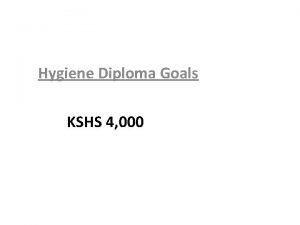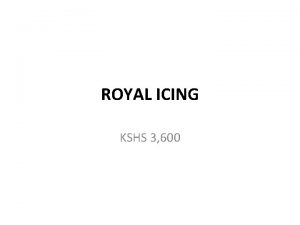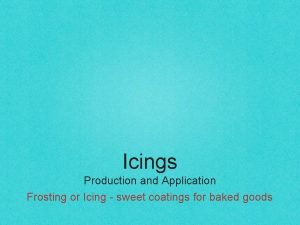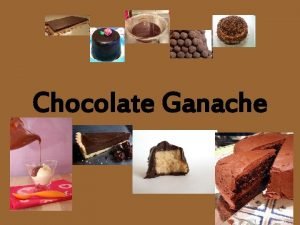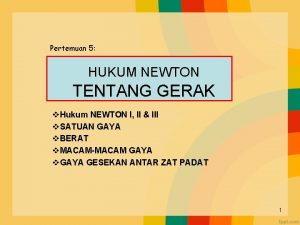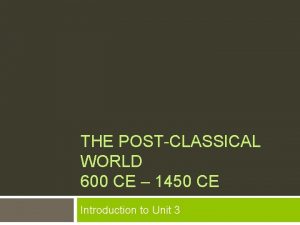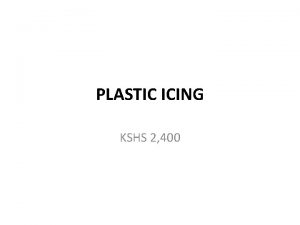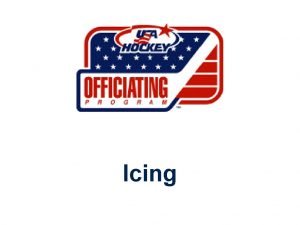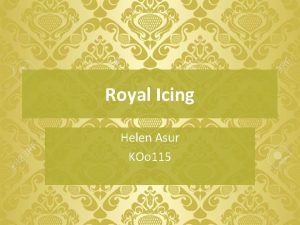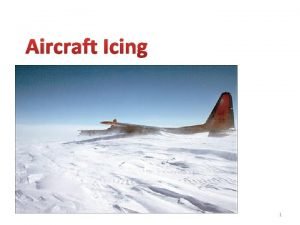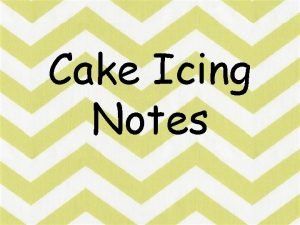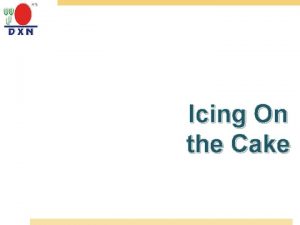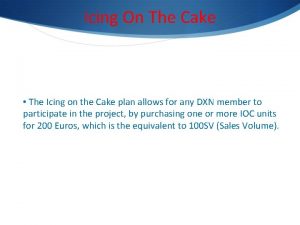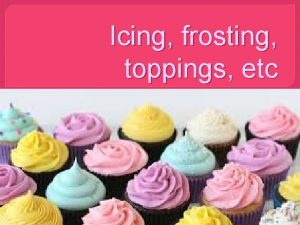ROYAL ICING KSHS 3 600 ROYAL ICING Royal


















- Slides: 18

ROYAL ICING KSHS 3, 600

ROYAL ICING Ø Royal icing is a mixture of egg whites and icing sugar. Confectioners mostly use dried egg whites for both convenience and to prevent the contamination by salmonella. However, fresh egg is used in the recipe below. Ø The icing sugar should be dry and powdery, the question of sieving it should not arise, if it is sieved, it could be contaminated with grease particles on the sieve that will destroy the aeration properties in the royal icing.

Free from grease Ø It is absolutely essential that the ingredients and utensils are free from grease. Ø The bowl and spatula and beater must not only be washed well, but should also be scalded with boiling water and allowed to dry by turning the bowl upside down. Never dry with a cloth because the slightest particle of grease will destroy the aerating properties of the egg whites.

The ingredients Ø The icing sugar should be dry and powdery and should not be sieved. There is a danger that particles of fat, could be on the sieve Recipe for royal icing Ø 300 ml Egg white Ø 1. 5 kg icing sugar

Method All of the equipment must be clean and free from grease. Ø The egg whites are placed into the mixing bowl Ø Stir in a third of the icing sugar and beat well Ø Gradually add the remainder of icing sugar a little at a time. Ø When using a mixer always use slow speed, never beat on high speed. This will produce too much aeration and will make coating and piping the royal icing more difficult. Ø A few drops of blue colour can enhance the whiteness of the icing.

Atmospheric conditions Ø It is also very important to realize that the atmospheric conditions play a very important part in the final results, and even with a hardener in the Royal icing it is important to have a low humidity to set and dry out royal icing work. Storage of royal icing Ø Royal icing must be covered at all times with a damp clean cloth, to prevent skinning. Ø Skinning of royal icing will allow the dry hard particles to block tubes whilst working which creates a great deal of time wasting. Ø Palette knives must never be left in the icing, because discoloration from the metal blade could take place, particularly if acid has been used.

Equipment The main equipment required is: Ø A turn table is designed to take the weight of the cake and one that can be rotated in any direction. Complicated turntables that can tilt with clips on are available for side work on cakes. Ø Palette knife, not too flexible. Ø Piping tubes No 1, 2, 3. Fine and coarse star tubes are ideal. Ø Plastic scraper. Ø Paper bags (see later how to make these). Savoy bags can be bought from shops Ø A straight edge, ideally made of metal is required to take across the top of the cake to create a smooth top.

The use of royal icing Ø Royal icing is an excellent medium for coating celebration cakes. Ø It is ideal for piping borders, particular with built up borders, line work and lettering. Ø Run out collars, figures, motives, and lettering, give that personalized addition to the cake. Ø Rock sugar is a boiledsugar solution poured with care on to royal icing and stirred with care the heat will allow an expansion of the beaten icing this sets quickly and is used as a decoration on Christmas cakes for a snow scene. (see the sugar boiling module)

Coating a cake with royal icing Ø When you coat a cake with royal icing, the icing should be soft, but not runny. After the first coating allow to set and then complete with the second coat of icing. Ø If you are piping inscription, it is better to allow the top of the cake to set and then complete with a piped border. Coating a square cake ` Ø The correct way to coat a square cake is firstly to coat the top and allow it to dry. Ø Then coat opposite sides, so that you remove the surplus royal icing by scraping down the dry side, this will produce a sharp edge. Allow to dry and then coat the opposite sides. Complete with a bevel on the board, which always makes the cake look larger and a professional finish.

Coating a round cake side first Ø The sides are coated first and then clean the surplus icing off the top for a sharp edge. Cover the top of the cake , use the straight edge to take off the surplus icing. Coat the board and use the scraper to smooth the board and create a bevel, this makes the cake look bigger. SIMPLE SCROLL WORK Piping of scrolls and shells. Ø This is produced from a fine star tube, No’s 44 and then over piped, with a number 3, 2 plain tube, the bright colour is in a No 1.

Piping technique Ø The base of the cake follows the top design with the fine lattice work on the built up over – piping. Ø Simple silver horseshoes completes the design Decorative run-out work Ø The use of run out collars eliminates the need to spend time on piping the edge of the cake. Ø The run out is executed on a flat firm metal or Perspex base, with a drawing of the dimensionsof the run-out , or motive to be produced, this is then covered with wax paper, each secured to the base with royal icing

Producing a run-out collar Ø Draw the design to fit within 2 cm on the cake Ø Cover with wax paper. Acetate paper is ideal and easy to remove Ø Follow the design with a bag of royal icing using a No 2 tube Ø Soften any points with a small paint brush dipped in egg whites Ø With a bag of softened royal icing, fill in the design, commencing from the piped edge , Ø Tap the metal tray slightly to make sure it is even , Ø Dry overnight in a warm atmosphere.

Run out collar Ø With great care slide a firm palette knife under the collar, Ø Secure to the cake with royal icing, Ø The collar edge can remain plain or bulbs can give filigree effect. Decorative run-out work Ø Pipe with a No 1 tube around the design Ø With a bag of softened sugar run in between the lines and fill in Ø Tap to see there is no air bubbles and that it is smooth. Ø Allow to dry in a warm cabinet Ø To remove, run a thin knife under the run out motive Ø Handle with care and place on to the cake, Ø Secure with a little royal icing.

COLOURS Ø White reflects all of the colour rays Ø Black absorbs them all reflecting none Ø Black and White do not possess colour. Ø They are achromatic. Ø Primary colors are Red Blue and Yellow Ø From these three, all other colors can be produced.

SECONDARY COLORS These are mixtures of any two primary colors: Ø Orange : red and yellow Ø Mauve: red and blue Ø Green: yellow and blue TERTIARY COLOURS: Ø These are mixtures of any two secondary colours. COMPLIMENTARY COLOURS: Ø These are the colours that contrast more strongly with onecolour than another



 Kshs term dates
Kshs term dates Royal icing ce
Royal icing ce Sudut istimewa
Sudut istimewa Icing sugar wiki
Icing sugar wiki Buttercream icings are light, smooth mixtures of
Buttercream icings are light, smooth mixtures of Icing regel
Icing regel Ganache icing definition
Ganache icing definition Carburetor icing
Carburetor icing Seljin
Seljin Tat sat temperature
Tat sat temperature Ice crystal icing
Ice crystal icing Et 500 gate motor battery
Et 500 gate motor battery 600-465
600-465 Hyper lipedema
Hyper lipedema Epid 600 unc
Epid 600 unc What is the present value of a $600 perpetuity
What is the present value of a $600 perpetuity Sebuah kotak 70kg digeser oleh gaya 400 n
Sebuah kotak 70kg digeser oleh gaya 400 n Cairan infus aminovel 600
Cairan infus aminovel 600 600
600
